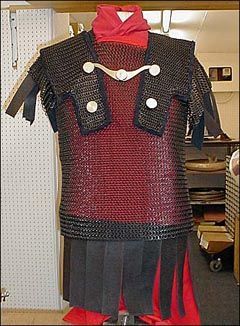Lorica hamata was a chain armour. Composed of many chains linked together, it resembled chain mail. It was probably invented by the Celts around the 7th century BCE. In the 4th century BCE, it was adopted by the Romans shortly after the Gallic invasion of the Apennine Peninsula. Made of steel or bronze circles, it formed an armour in the form of a vest, sometimes with a short sleeve.
During the wars between Rome and Carthage only the richest soldiers among the so-called triarii and principes. Its effectiveness is evidenced by the fact that after the Battle of Cannae in 216 BCE. soldiers of Hannibal stripped the dead Romans of chain mail, replacing them with linen armour linothorax and torso cuirass. After Marius’ reform at the end of the 2nd century BCE, which transformed the civic army into a professional army, chain mail became standard equipment for a legionary until around the time of Emperor Tiberius. The hamata was most often found in two versions with a reinforcement on the shoulders in the form of a collar. The former imitated the Greek linothorax connected at the front with a metal plate or S-shaped hook. The second had a collar that mimicked a Gallic chain cloak, protecting also the shoulders.
The armour was about the middle of the thighs. Its shape resembled a military tunic, but it was slightly shorter and had shorter sleeves. Due to its flexibility, the armour was very comfortable to wear and did not restrict freedom of movement in the least. It effectively protected against blows and stabs with a white weapon, and significantly weakened the strength of the spear and spear strike.
The weight of the armour ranged from 8 to 10 kg. In the time of Augustus, these armours were reinforced by doubling the thickness of the upper back and shoulders.
A tunic was put under the lorica. They were very eagerly worn by riders.
Around the middle of the 1st century CE a shortened version of the armour, loricae hamatae, appeared, which was even lighter than the one used so far, as their weight was reduced to 6 kg. The shorter chain armour gained great popularity, especially in the auxiliary troops.
Chain mail was time – and laborious. Its execution, depending on the complexity and size, could take up to several months. Usually, it consisted of about 20 thousand. cells with a diameter of 4 to 8 mm. The most common weave is 1 in 4. One open link closed the other four with a rivet. Full links were obtained most often by punching them out of metal sheets. Other strands were made of cut wire and the links were closed by folding them without riveting. Of course, their strength and resistance to blows depended on the quality of the weave. The weight of chain mail is on average 8 to 12 kilograms. Hamata, like all armour, had advantages and disadvantages. Its main advantages were flexibility and breathability. It protected well against cuts, much worse against thrusts and arrowheads that could break the links. It was laborious and relatively heavy. Its weight rested mainly on the soldier’s shoulders. It was partially eliminated by the balteus (soldier’s belt), which took the weight on the lap belt.
Lorica hamata was the type of armour that was used the longest in the Roman army, until the fall of the empire. The soldiers appreciated its comfort and lightness compared to the heavy and embarrassing movements of the sectional armour.








